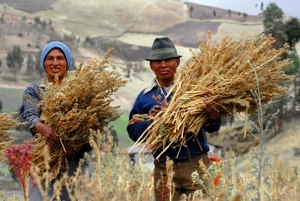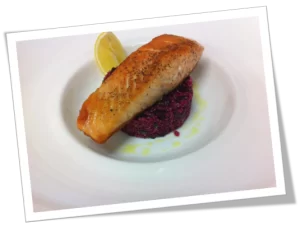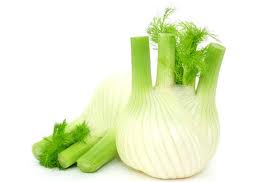Quinoa and its unsuspected benefits for our health!
April 24, 2022
Quinoa, “pseudo-cereal” or “Inca gold”…

The mother of all seeds is called Quinoa! It resembles rice in taste and appearance, it combines a delicate nutty and slightly earthy taste, with a texture that adjusts from soft to crunchy.
Resembling, but far from rice and wheat, Quinoa is considered a “pseudo-cereal”. It has in its toolbox a large amount of high quality protein, polyunsaturated fatty acids and many micronutrients.
Unlike other grasses, Quinoa contains a large dose of magnesium, one of the minerals that helps our blood vessels to dilate, with an immediate result in reducing the frequency of migraines. Thanks to this richness in essential elements for our health, Quinoa has been able to build a past and a present that it is important to scrutinize.
A thousand-year-old culture, Quinoa…
Of the “chisaya mama” as it was called in the Andes of South America, after its scientific name Chenopodium quinoa, Quinoa, cumulates more than 5 millennia of existence. For millennia, quinoa has been cultivated in the Andes of South America and scientists believe that the domestication of quinoa happened at the same time as that of the llama. Llamas lived in mutual dependence with Quinoa more than 7,000 years ago.
The llama's ancestor, the guanaco, could take advantage of the only rare plant that could survive the inhospitable environment that was the Andean Altiplano. Its seed germinated thanks to the manure of these llamas, on the ground of the primitive enclosures built by the first farmer breeders. Thus, the plants grew rapidly and fruited. Moreover, although it contributed effectively to the expansion of the Inca culture in the Andes, the culture of Quinoa was prohibited by the Spaniards, in favor of wheat and barley.

However, this remarkable seed has supplanted four centuries of prohibition, to become today the first and main source of protein for the majority of the population in the southern Altiplano of Bolivia. As a result, quinoa locally feeds and sustains the lives of more than 20,000 Bolivians. Both in Bolivia and around the world, the appearance of Quinoa makes it be mistaken for a variety of cereal. Quinoa is rather part of the spinach and beet family, scientifically classified Chenopodiaceae, and which is full of important elements for our health
The benefits of Quinoa on our health…
Already, the results of certain epidemiological studies indicate that the consumption of whole grains reduces the risk of cardiovascular disease and diabetes, certain cancers and obesity.
For Anne-Sophie Foucault in her doctoral thesis on the effects of a quinoa extract enriched with 20-hydroxyecdysone in a nutritional obesity model in clinical application, among the new active ingredients that have been researched in plants, phytoecdysteroids, in particular the 20-hydroxyecdysone present in quinoa, have shown beneficial pharmacological effects, and would therefore be potentially effective candidates against obesity. Further, Quinoa contains important dietary fibers. It can be noted that the types of fibers found in quinoa flour help improve digestion and absorption of quinoa in the large intestine.
In addition, nutritionists Paulette Vanier and Josiane Cyr point out that a diet rich in soluble fiber helps in the treatment of cardiovascular disease and type 2 diabetes since it normalizes blood cholesterol, glucose and insulin levels. According to Oshodi et al. (1999), insoluble fibers help maintain adequate intestinal function. Thus, a diet rich in fiber would reduce the risk of colon cancer. Certainly, Quinoa is not high in calories, but its high total fiber intake brings a greater feeling of satiety.
And protein!
Not only is the amino acid composition of quinoa better balanced than that of other cereals, but it also contains about 15 % of protein. Protein helps us build, repair and maintain our tissues, skin, muscles and bones. Quinoa has a valuable impact on our skeleton, and allows it to stay in top shape. It helps prevent osteoporosis. We will not forget to mention that quinoa is a food rich in non-heme iron (vegetable iron) or 1.85 mg of iron for 20 g of quinoa. Consuming Quinoa is also a good way to include more iron in our diet, especially for people with anemia.
For Chef Guy Dongue,
"With all the amino acids necessary for life contained in Quinoa and which cannot be produced by our body, we have the best reasons to consume it very regularly"

As usual, Chef Guy Dongué has concocted an original recipe based on Quinoa, it is the delicious Tabbouleh of Quinoa with vegetables!
How to prepare Tabbouleh of quinoa with vegetables?
We invite you to consult the tab " Receipts " to discover the steps: https://cuisinesantelab.com/all-recipes/
To your kitchens and good practice!
Do not hesitate to contact Chef Guy Dongué if you need practical advice, It's free!
By phone at (647)-836-9021; by email to [email protected] or cuisinesantef@gmail.com
You may like these too
Service Canada supports the employability of young Francophones in Ontario during the summer
Toronto, June 08, 2022 – Canadians Healthy Cuisine (SCC) is pleased to announce the
June 8, 2022
Salmon for the health of our women and our elders!
Nothing more varied, nothing more colorful than the magnificent creatures that inhabit our ma
April 24, 2022
Quinoa and its unsuspected benefits for our health!
Quinoa, “pseudo-cereal” or “Inca gold”… The mother of all
April 24, 2022
Fennel in your dishes, and for your health!
Fennel, a symbolic antidote We are in the thirteenth century, on rocky grounds and
April 24, 2022


